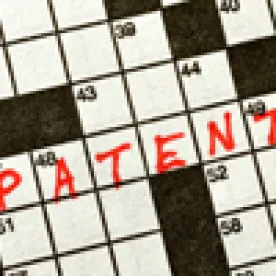In its Final Written Decision, the Board found that all challenged claims of the ’251 Patent, claims 1, 6, and 8-13, were unpatentable. The ’251 Patent relates to a synthetic biomaterial compound based on stabilized calcium phosphates and adapted for supporting bone cell activity.
The Board began with claim construction, stating that the claim terms should be given their broadest reasonable interpretation in light of the specification. The Board first construed the term “isolated . . . compound.” Petitioner argued the term should be construed as “a multi-phasic mixture containing a substituted-TCP [(tricalcium phosphate)] phase, which has been separated from other starting materials used to synthetically or otherwise prepare that multi-phase compound.” However, the Board disagreed, stating that the “claimed ‘isolated . . . compound’ is not limited to compounds including a silicon-substituted TCP phase,” and noting that the claims use the open-ended phrase “comprising calcium, oxygen and phosphorous.” The Board further determined that the word “isolated” has its plain and ordinary meaning of “separated from all other substances.” Thus, the term was construed as “a stabilized single phase or multi-phase calcium phosphate compound separated from all other substances.”
The Board then reviewed the term “microporous structure.” Petitioner argued that “microporous structure” means a structure having pore sizes of about a micron or less.” Patent Owner agreed “so long as the material is indeed porous to the flow of fluids, i.e., ‘or less’ does not equate to not porous at all.” Patent Owner’s argument implies that the porosity of the material cannot be eliminated by complete sintering of the particles. In its Decision to Institute, the Board construed the term to mean “a porous structure of interconnected particles having pore sizes of about 2 microns or less in diameter.” Patent Owner further argued in its Patent Owner’s Response that the term should also be limited to “a structure having (i) ‘interconnected microporosity,’ and (ii) pore sizes greater than 0.1 micron in diameter so as to exclude a ‘nanoporous structure.’” Petitioner replied that Patent Owner’s expert agreed that references from the time period of the patent application referred to nanometer-sized pores as “microporous” and thus “microporous” should not exclude nanoporous. The Board noted that claim 6, which depends from claim 1, expressly limits the porous structure to one of “interconnected voids” having a specific range of pore sizes. Accordingly, the Board did not find any reason to limit claim 1 as proposed by Patent Owner. Therefore, the Board maintained its construction of “microporous structure” provided in its Decision to Institute. Additional claim terms were briefly discussed, but the Board found no reason to alter its constructions from its Decision to Institute.
The Board then turned to the ground of unpatentability that claims 1 and 8-13 are anticipated by Davies. Petitioner argued that Davies inherently anticipates the claims by describing the same process described in the ’251 Patent, which Petitioner argued would necessarily result in the claimed isolated compound. Patent Owner argued that the process described in the ’251 Patent that Petitioner alleges is described in Davies is a non-elected, unclaimed embodiment in the ’251 Patent and that it does not result in an “isolated” compound. The Board agreed with Patent Owner’s arguments and expert testimony that the process in Davies requires a thin film applied to or coated on a quartz substrate, and thus is bound to, not separated from, another substance. Accordingly, the Board found that a “preponderance of the evidence does not support Petitioner’s contention that Davies anticipates claim 1 of the ’251 Patent,” or any of the other grounds relying on Davies.
Next, the Board then turned to the ground of unpatentability that claims 1 and 8-13 are anticipated by Ruys ’93a. Petitioner argues that Ruys ’93a inherently anticipates claims 1 and 8-13 because it discloses “a silicon-substituted calcium phosphate compound made by a very similar process to the sol-gel/sintering process described in Examples 1, 2, and 5 of the ’251 Patent.” Patent Owner opposed by emphasizing differences between the processes described in Ruys ‘93a and the ’251 Patent. Specifically, Patent Owner argued that Petitioner did not prove that the process of Ruys ’93a necessarily results in the claimed microporous structure. The Board noted that Ruys ’93a clearly shows the disclosed silicon-substituted CaP compound having a porous structure in Figure 2 of the reference, which is a graph providing the “apparent porosity” curve. The dispute hinged on whether even though Ruys ’93a was silent on the pore size, it inherently disclosed a “microporous structure.” Patent Owner argued that the process of Ruys ’93a differed from example 5 of the ’251 Patent with regard to the size of the HA particles and by sintering temperature. However, the evidence still supported the conclusion that the process disclosed in Ruys ’93a could still form a “microporous structure” as that term was construed by the Board. Accordingly, the Board found that a preponderance of the evidence does support Petitioner’s contention that Ruys ’93a inherently anticipates claim 1 and 8-13 of the ’251 Patent. The Board also found sufficient evidence to support Petitioner’s obviousness ground based on Ruys ’93a and another reference asserted for claim 6.
Baxter Healthcare Corp., Apatech, Inc., and Apatech Limited v. Millenium Biologix, LLC, IPR2013-00582
Paper 48: Final Written Decision
Dated: March 18, 2015
Patents: RE41,251
Before: Michelle R. Osinski, Scott E. Kamholz, and Brian P. Murphy
Written by: Murphy
Related Proceedings: Millenium Biologix, LLC v. Baxter Healthcare Corp., Civil Action No. 1:13-cv-03084 (N.D. Ill.); IPR2013-00590 (U.S. Pat. No. 6,585,992)



 />i
/>i

